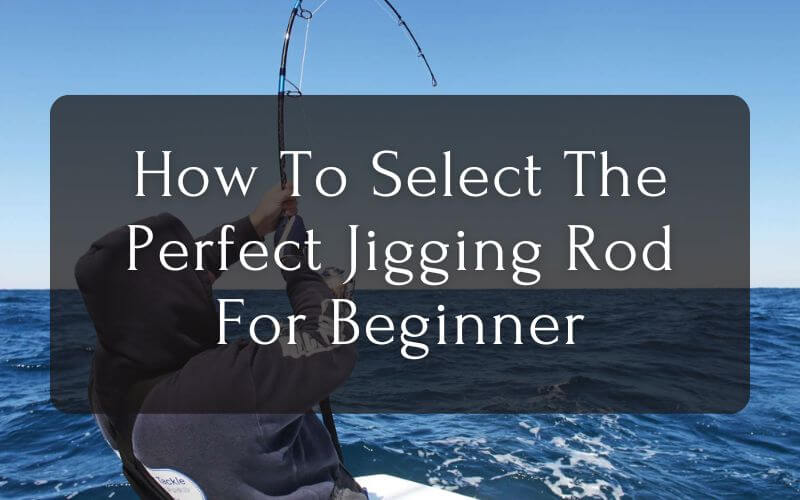Jigging spreads quickly and has become one of the fascinating sports worldwide. However, for beginners, choosing a fishing rod is an actual challenge. So, how to select the perfect jigging rod for beginners?
Should it be short or long? Graphite or fibreglass? What type of rig is the best? Does it need much technique to use each kind of rod? And among different massive rods, you have to select a suitable one on the market. This task seems quite exhausting but exciting as well. You need to know something first before finding your right rod!
This article will help you find the perfect jigging rod for beginners. Let’s move on now!
What Is A Jig Rod?
Jigging is the technique of fishing on a boat. The fishing lures are metal baits shaped like small fish, shrimp, or squid.
How To Choose Suitable Material Jigging Rod For Beginners?
Of course, what we are talking about first is the rod. A poor rod is a limiting factor for any angler, and a good rod may not instantly make you a better angler. It also helps you feel much more of what’s going on with your lure.
The rod should be a combination of flexibility and strength, so the material is essential. Most good rods are made from Graphite(Carbon). The advantage of this material is that they are truly durable and light. However, they are easy to be damaged. You can try a fibreglass one if you are on a tight budget. They are less expensive, but a little bit heavy and the flexibility is not so good. They are not strong enough to catch a big fish. You will need a powerful rod with a casting weight between 60 and 200 grams; it depends on the lure density and targeted fish size.
What About Length And Weight?
The lengths of rods are also another thing to mention. Does this depend on your fishing habit: big fish or small fish? Where are you going to fish? Etc. The ideal length is usually somewhere between 6’5″ and 7’5″. Graphite rods tend to be heavier than fibreglass ones, but they are more flexible.
Also significant is the weight. If you are going jigging in the sea or have a camp trip, you will need something to catch and handle a big fish. On the contrary, a light rod is recommended if jigging around a pond or lake.
Action Is Important
Another factor when talking about Jigging is action. The action relies on the location on the blank where the rods bend, or we can say action can be described as how much the rod bends and how it handles the movement from bait or lure. When you choose a fast action rod, it will bend in only the top third when you choose. With medium or moderate action, the rod will bend in the middle, and starting in the lower third will bend with a slow action. Jigging usually requires a fast-action rod because it helps to create flexibility. It also needs to have strength and backbone to catch big fish, just in case.
Related post: Best Spinning Rod – Top 10 Fishing Rods
Power Of Jig Rod
Do not forget about the rod’s power while you are considering getting one. The power helps to know the strength and how much a rod can lift the fish. This factor also depends on where you are going to fish because the type of water is different. For instance, clear and open water often requires thin, hard-to-see lines to get bit, which means you will need a lighter power rod.
As mentioned before, jigging anglers use a fake metal lure to catch fish. Jigs are the most common lures. It falls to the bottom of the water before they require the most skill as you must cast it out and retrieve it to induce a strike with its movement. Feeling the strike can be brutal as jigs may get caught on debris or just feel like they’re moving along with the current. Many anglers also use a weedless jig to help keep the weeds off the hook. However, they must control the lure’s action because when it is running through heavy cover with weeds all around it, there is no chance that a fish can bite.
A Suitable Hook Size
Choosing a jig is not easy at all. We need to determine what kind of materials to set up a jig. First of all, it is the hook. The size of the hook depends on the species of fish, as larger hooks are better for big fish and vice versa. Anglers tend to get a circle hook for its high ability to hook into a first. Typically, it is the 5/0 circle hook and 8/0 circle hook for the average-sized fish and bigger fish.
Another Factor Is The Leader Line
It provides tough and durable protection against breaking your fishing line as all your fish finder rigs will be attached. What if your line is twisting or breaking or even being tangled? Well, a barrel swivel helps to prevent those things.
Moreover, a sinker on the end of your line will give your setup plenty of weight, enable you to cast further, and keep your bait down in the water. And last but not least, a leader is one more thing we need to know; it can come in many shapes and sizes. If you are fishing for small fish species, a small leader of 6 to 8 inches will be sufficient. A leader of anywhere from 15 to 30 inches is usually ideal for larger fish.
Related post: Slip Bobber Rigging (Quickstart Guide)
Conclusion
After all, a good rod can help you to have a chance to catch fish. It is the most important factor in having successful fishing.

